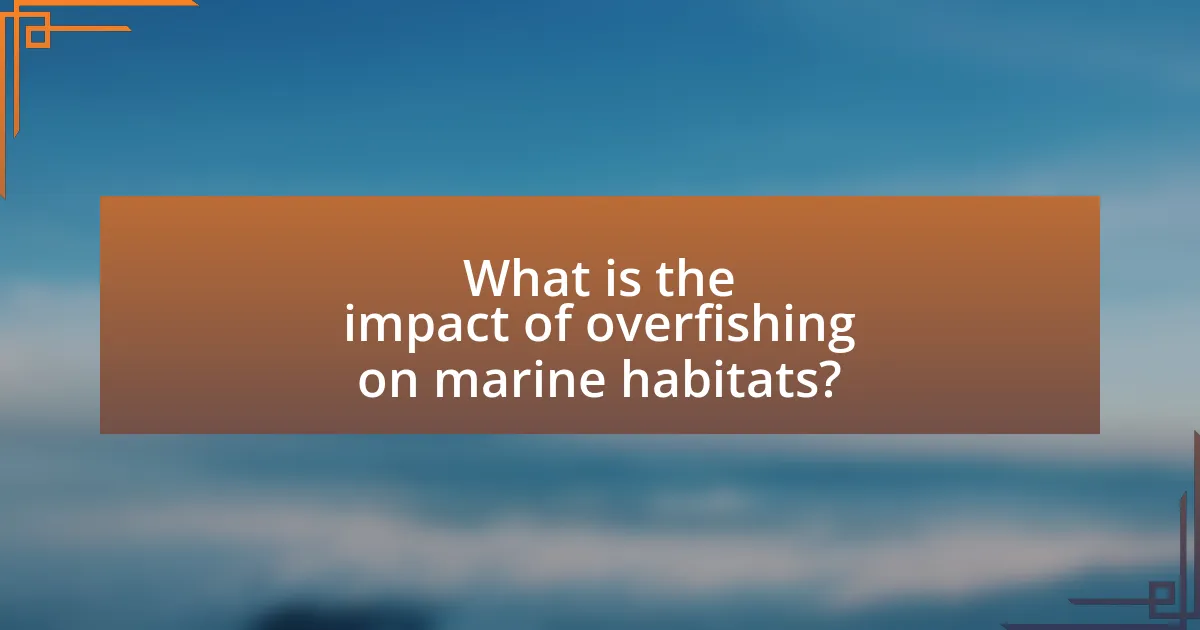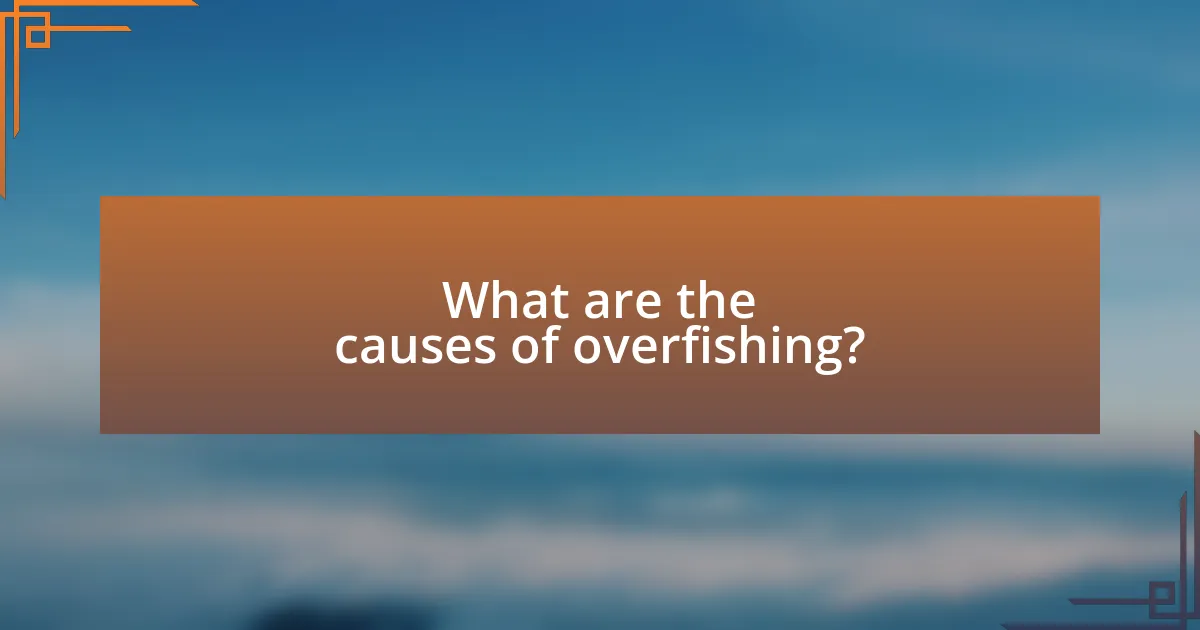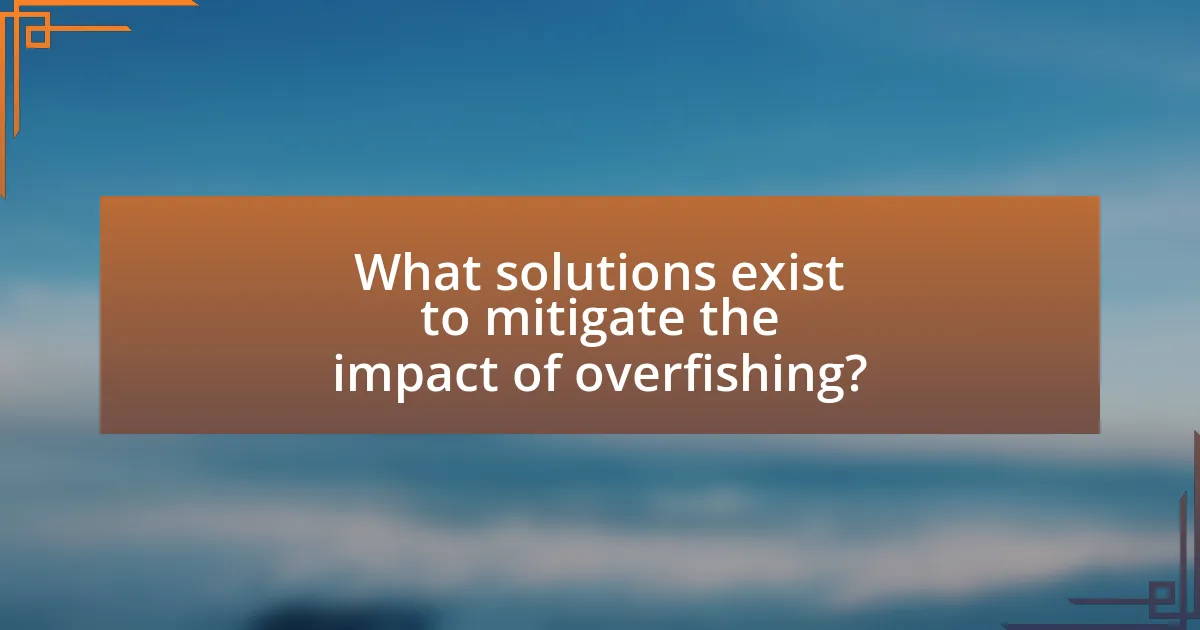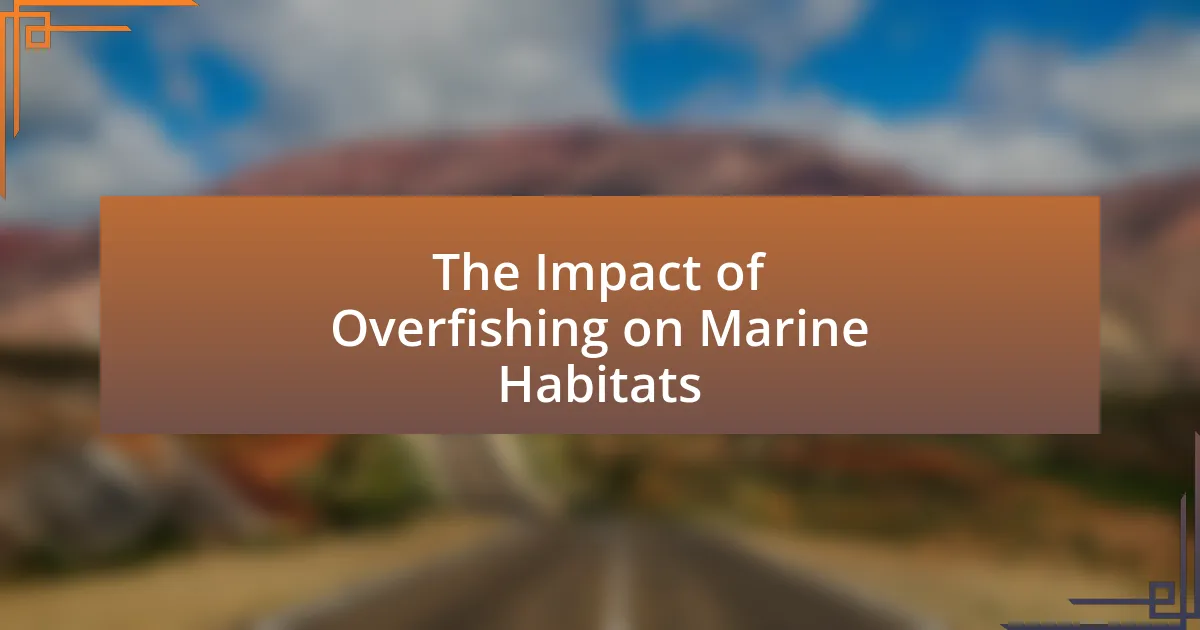The article examines the impact of overfishing on marine habitats, highlighting how excessive fishing practices deplete fish populations and disrupt marine ecosystems. It details the consequences of overfishing, including the decline of biodiversity, the disruption of food chains, and the destruction of critical habitats such as coral reefs and seagrass beds. Key species affected by overfishing, such as cod and tuna, are discussed, along with the ecological and economic implications for local communities and global food security. The article also explores the causes of overfishing, the effectiveness of current regulations, and potential solutions, including sustainable fishing practices and the establishment of marine protected areas.

What is the impact of overfishing on marine habitats?
Overfishing significantly depletes fish populations, disrupting marine ecosystems and habitats. When fish are removed at unsustainable rates, it leads to imbalances in the food web, affecting predator-prey relationships and resulting in the decline of species that rely on these fish for survival. For example, studies indicate that overfishing has led to a 90% decline in certain fish stocks, which in turn affects the health of coral reefs and other marine environments. Additionally, the destruction of habitats such as seagrass beds and mangroves occurs due to the practices associated with overfishing, including trawling and bycatch, which further exacerbates the degradation of marine ecosystems.
How does overfishing affect marine biodiversity?
Overfishing significantly reduces marine biodiversity by depleting fish populations and disrupting ecosystems. When specific species are overfished, it leads to imbalances in the food web, affecting predator-prey relationships and resulting in the decline of other marine organisms. For instance, the overfishing of key species like cod has been shown to alter the structure of marine communities, leading to a decrease in species diversity. According to a study published in the journal “Nature,” overfishing can cause a 50% reduction in species richness in affected areas, demonstrating its profound impact on marine biodiversity.
What species are most affected by overfishing?
The species most affected by overfishing include cod, tuna, and haddock. These fish populations have experienced significant declines due to excessive fishing pressures. For instance, Atlantic cod stocks have dropped by over 90% since the 1960s, primarily due to overfishing practices. Similarly, bluefin tuna populations have been severely depleted, with estimates indicating that their numbers have fallen by approximately 97% from historical levels. Haddock has also faced similar challenges, with stocks in the North Atlantic being heavily overfished, leading to strict fishing quotas. These statistics highlight the critical impact of overfishing on these key marine species.
How does the loss of species impact the ecosystem?
The loss of species significantly disrupts ecosystem balance and functionality. When species are removed, it can lead to a decline in biodiversity, which is crucial for ecosystem resilience and stability. For example, the removal of a keystone species, such as sea otters, can result in unchecked sea urchin populations, leading to the destruction of kelp forests. This phenomenon has been documented in studies showing that overfishing of sea otters in the North Pacific has led to a dramatic decline in kelp ecosystems, which serve as vital habitats for numerous marine organisms. Thus, the loss of species directly correlates with negative impacts on ecosystem health and biodiversity.
What are the ecological consequences of overfishing?
Overfishing leads to significant ecological consequences, including the depletion of fish populations and disruption of marine ecosystems. When fish are removed at unsustainable rates, it results in a decline in species diversity, as certain species become overexploited while others may proliferate unchecked, leading to imbalances in the food web. For instance, studies indicate that overfishing has caused a 90% decline in large predatory fish populations since the mid-20th century, which disrupts predator-prey relationships and can lead to the collapse of local fisheries. Additionally, overfishing can result in habitat destruction, particularly through practices like bottom trawling, which damages seabed ecosystems and affects the organisms that rely on these habitats for survival.
How does overfishing disrupt food chains?
Overfishing disrupts food chains by depleting key fish populations, which are essential for maintaining ecological balance. When predator fish are overfished, their prey species can proliferate unchecked, leading to imbalances that affect the entire marine ecosystem. For instance, the overfishing of cod in the North Atlantic has resulted in an increase in smaller fish populations, which in turn affects the availability of plankton and other organisms that rely on these smaller fish for survival. This cascading effect illustrates how the removal of a single species can lead to significant changes in community structure and function within marine habitats.
What role do keystone species play in marine habitats?
Keystone species play a critical role in maintaining the structure and health of marine habitats. These species, such as sea otters and certain types of sharks, significantly influence the ecosystem by regulating populations of other species, which helps to maintain biodiversity. For example, sea otters control sea urchin populations, preventing overgrazing of kelp forests, which are vital habitats for numerous marine organisms. The removal or decline of keystone species can lead to dramatic shifts in the ecosystem, often resulting in decreased biodiversity and altered habitat structures, as evidenced by studies showing that the decline of sea otters has led to the overpopulation of sea urchins and subsequent kelp forest destruction.
Why is overfishing a global concern?
Overfishing is a global concern because it depletes fish populations faster than they can reproduce, leading to ecological imbalances and threatening marine biodiversity. According to the Food and Agriculture Organization (FAO), approximately 34% of global fish stocks are overfished, which disrupts food chains and affects the livelihoods of millions who depend on fishing for their income and nutrition. The decline in fish populations also impacts marine habitats, as species that rely on fish for food face increased risk of extinction, further destabilizing ocean ecosystems.
How does overfishing affect local economies?
Overfishing negatively impacts local economies by depleting fish stocks, which reduces income for fishermen and related industries. In coastal communities, where fishing is a primary source of livelihood, the decline in fish populations leads to decreased catch, resulting in lower earnings for fishers. For example, a study by the Food and Agriculture Organization (FAO) indicated that overfishing has led to a 50% decline in global fish stocks since the 1970s, directly affecting the economic stability of communities reliant on fishing. Additionally, reduced fish availability can increase prices, making seafood less accessible to local consumers and further straining the economy.
What are the implications for food security?
Overfishing significantly threatens food security by depleting fish stocks that are crucial for the diets of millions globally. The Food and Agriculture Organization (FAO) reports that nearly 3 billion people rely on fish as a primary source of protein, and overfishing disrupts this vital food supply. As fish populations decline, communities that depend on fishing for their livelihoods face economic instability, leading to increased poverty and food scarcity. Furthermore, the loss of marine biodiversity due to overfishing can destabilize ecosystems, reducing the resilience of fish populations and further jeopardizing food security.

What are the causes of overfishing?
Overfishing is primarily caused by excessive fishing practices that exceed sustainable limits. Factors contributing to overfishing include high demand for seafood, advancements in fishing technology, lack of effective management and regulation, and illegal fishing activities. For instance, the Food and Agriculture Organization reported that approximately 34% of global fish stocks are overfished, highlighting the unsustainable pressure on marine resources. Additionally, the use of industrial fishing methods, such as trawling, leads to significant bycatch and habitat destruction, further exacerbating the issue.
How do fishing practices contribute to overfishing?
Fishing practices contribute to overfishing primarily through unsustainable harvesting methods that exceed the reproductive capacity of fish populations. For instance, industrial fishing techniques, such as trawling and longlining, often capture large quantities of fish, including juvenile and non-target species, leading to significant declines in fish stocks. According to the Food and Agriculture Organization (FAO), approximately 34% of global fish stocks are overfished, primarily due to these aggressive fishing practices. Additionally, practices like bycatch and the use of destructive gear further exacerbate the depletion of marine life, disrupting ecosystems and hindering recovery efforts.
What are the most common fishing methods used today?
The most common fishing methods used today include trawling, longlining, gillnetting, and purse seining. Trawling involves dragging a net along the sea floor or through the water column to catch fish, while longlining uses a main line with baited hooks spaced along it to target specific species. Gillnetting employs a wall of netting that entangles fish, and purse seining involves encircling schools of fish with a large net. According to the Food and Agriculture Organization (FAO), these methods account for a significant portion of global fish catches, highlighting their prevalence in modern fishing practices.
How do these methods impact marine habitats?
Overfishing methods significantly degrade marine habitats by disrupting the ecological balance and depleting fish populations. These practices lead to habitat destruction, particularly through bottom trawling, which physically damages seafloor ecosystems and reduces biodiversity. Research indicates that overfishing can result in the collapse of fish stocks, with studies showing that approximately 34% of global fish stocks are overfished, leading to long-term ecological consequences. Additionally, the removal of key species alters predator-prey dynamics, further destabilizing marine environments.
What role do regulations play in overfishing?
Regulations play a crucial role in mitigating overfishing by establishing limits on catch sizes, fishing seasons, and protected areas. These regulations are designed to ensure sustainable fish populations and protect marine ecosystems. For instance, the implementation of quotas can prevent the depletion of specific fish species, while marine protected areas can provide safe habitats for breeding and recovery. According to the Food and Agriculture Organization, effective fisheries management through regulations has been shown to lead to a 20% increase in fish stocks in regions where such measures are enforced.
How effective are current fishing regulations?
Current fishing regulations are moderately effective in managing fish populations and protecting marine habitats. Studies indicate that regions with strict regulations, such as catch limits and seasonal closures, have shown signs of recovery in fish stocks. For example, the implementation of the Magnuson-Stevens Fishery Conservation and Management Act in the United States has led to a significant increase in the biomass of overfished species, with a reported recovery of 40 fish stocks between 2000 and 2018. However, enforcement challenges and illegal fishing practices undermine these regulations, limiting their overall effectiveness.
What changes are needed to improve sustainability?
To improve sustainability in marine habitats affected by overfishing, implementing stricter fishing regulations is essential. These regulations should include establishing catch limits based on scientific assessments of fish populations, which can help prevent overexploitation. For instance, the World Wildlife Fund reports that sustainable fishing practices can lead to a 20% increase in fish populations over time. Additionally, creating marine protected areas can enhance biodiversity and allow ecosystems to recover, as evidenced by studies showing that such areas can increase fish biomass by up to 600%. Lastly, promoting aquaculture as a sustainable alternative to wild fishing can reduce pressure on marine resources, with the Food and Agriculture Organization noting that responsible aquaculture can provide a significant source of seafood while minimizing environmental impact.
How does consumer demand influence overfishing?
Consumer demand significantly influences overfishing by driving the market for seafood, leading to increased fishing pressure on marine populations. As consumers seek more seafood, particularly popular species like tuna and cod, fisheries respond by intensifying their efforts to catch these fish, often exceeding sustainable limits. According to the Food and Agriculture Organization (FAO), approximately 34% of global fish stocks are overfished, largely due to high consumer demand for specific species. This demand not only depletes fish populations but also disrupts marine ecosystems, as the removal of key species can lead to imbalances in the food web.
What are the trends in seafood consumption?
Seafood consumption trends indicate a growing preference for sustainable and responsibly sourced products. According to the Food and Agriculture Organization (FAO), global seafood consumption reached approximately 20.5 kg per capita in 2020, reflecting a steady increase over the past decades. Additionally, consumer awareness regarding overfishing and environmental impacts has led to a rise in demand for certified seafood, such as those bearing the Marine Stewardship Council (MSC) label. This shift is further supported by market research showing that 66% of consumers are willing to pay more for sustainably sourced seafood, highlighting a significant trend towards environmentally conscious purchasing decisions.
How can consumers promote sustainable fishing practices?
Consumers can promote sustainable fishing practices by choosing seafood that is certified by reputable organizations, such as the Marine Stewardship Council. This certification ensures that the seafood is sourced from fisheries that adhere to sustainable practices, helping to prevent overfishing and protect marine habitats. According to the World Wildlife Fund, sustainable seafood choices can significantly reduce the demand for overfished species, thereby supporting the recovery of fish populations and the ecosystems they inhabit. Additionally, consumers can advocate for policies that promote sustainable fishing and support local fisheries that practice responsible fishing methods.

What solutions exist to mitigate the impact of overfishing?
Solutions to mitigate the impact of overfishing include implementing sustainable fishing practices, establishing marine protected areas (MPAs), and enforcing stricter regulations on catch limits. Sustainable fishing practices, such as using selective gear and reducing bycatch, help maintain fish populations. MPAs, which cover significant portions of marine ecosystems, allow fish stocks to recover and thrive, as evidenced by studies showing increased biodiversity and biomass in these areas. Stricter regulations, including quotas and seasonal closures, are essential for preventing overexploitation, with research indicating that countries enforcing such measures have seen improvements in fish populations and ecosystem health.
How can marine protected areas help?
Marine protected areas (MPAs) can help by conserving biodiversity and restoring fish populations. By restricting fishing and other harmful activities, MPAs create safe havens for marine species, allowing ecosystems to recover. Research indicates that MPAs can lead to a 20-50% increase in fish biomass within their boundaries, which supports healthier marine habitats and enhances resilience against overfishing. Additionally, studies show that MPAs can improve the spillover effect, where fish populations in protected areas migrate to adjacent areas, benefiting local fisheries.
What are the benefits of establishing marine reserves?
Establishing marine reserves provides significant ecological and economic benefits. Marine reserves protect biodiversity by creating safe havens for various marine species, allowing populations to recover from overfishing and habitat destruction. Research indicates that marine reserves can lead to a 20-30% increase in fish biomass within their boundaries, which supports healthier ecosystems. Additionally, these reserves enhance local fisheries by providing a source of larvae and adult fish that can spill over into adjacent areas, thereby boosting catches for local fishermen. Studies have shown that well-managed marine reserves can increase fishery yields by up to 50% in surrounding waters.
How do marine protected areas contribute to biodiversity recovery?
Marine protected areas (MPAs) contribute to biodiversity recovery by providing safe habitats where marine species can thrive without the pressures of overfishing and habitat destruction. These designated zones allow ecosystems to regenerate, leading to increased populations of various species, including commercially important fish. Research indicates that MPAs can lead to a 20-50% increase in fish biomass within their boundaries compared to unprotected areas, as demonstrated in a study published in “Nature” by Lester et al. (2009). This recovery of fish populations not only enhances biodiversity but also supports the resilience of marine ecosystems, making them better equipped to withstand environmental changes.
What role does sustainable fishing play in conservation?
Sustainable fishing plays a crucial role in conservation by ensuring that fish populations remain healthy and ecosystems are preserved. This practice involves catching fish at a rate that allows for their natural regeneration, thereby preventing overfishing, which can lead to the collapse of fish stocks and degradation of marine habitats. According to the Food and Agriculture Organization, sustainable fishing practices can help maintain biodiversity, support the resilience of marine ecosystems, and contribute to the overall health of ocean environments. By implementing measures such as catch limits, protected areas, and responsible fishing techniques, sustainable fishing directly mitigates the negative impacts of overfishing, promoting long-term ecological balance.
What practices define sustainable fishing?
Sustainable fishing is defined by practices that ensure fish populations remain healthy and ecosystems are preserved. Key practices include implementing catch limits based on scientific assessments to prevent overfishing, using selective fishing gear to minimize bycatch, and protecting critical habitats such as spawning grounds. According to the Food and Agriculture Organization, sustainable fishing practices contribute to the long-term viability of fish stocks and the overall health of marine environments, thereby supporting biodiversity and ecosystem resilience.
How can fisheries be managed sustainably?
Fisheries can be managed sustainably by implementing science-based quotas, protecting critical habitats, and promoting responsible fishing practices. Science-based quotas ensure that fish populations are harvested at sustainable levels, preventing overfishing and allowing stocks to replenish. For example, the establishment of Total Allowable Catches (TACs) based on stock assessments has been effective in various regions, such as the North Atlantic, where cod stocks have shown signs of recovery. Protecting critical habitats, such as spawning grounds and nursery areas, is essential for maintaining healthy fish populations. Additionally, promoting responsible fishing practices, including the use of selective gear and reducing bycatch, contributes to the sustainability of fisheries. The combination of these strategies helps maintain the balance of marine ecosystems and supports the livelihoods of communities dependent on fishing.
What actions can individuals take to combat overfishing?
Individuals can combat overfishing by choosing sustainable seafood options, advocating for responsible fishing practices, and supporting marine conservation initiatives. By selecting seafood certified by organizations like the Marine Stewardship Council, individuals help promote fisheries that are managed sustainably. Additionally, individuals can engage in advocacy efforts, such as signing petitions or contacting policymakers to support regulations that protect fish populations and habitats. Supporting organizations focused on marine conservation, such as Oceana or the World Wildlife Fund, also contributes to efforts aimed at reducing overfishing and restoring marine ecosystems.
How can consumers make informed seafood choices?
Consumers can make informed seafood choices by researching sustainable seafood sources and understanding fishing practices. Utilizing resources such as the Marine Stewardship Council and the Seafood Watch program, consumers can identify seafood that is caught or farmed in environmentally responsible ways. These organizations provide guidelines and ratings based on the sustainability of fisheries and aquaculture operations, helping consumers avoid products linked to overfishing and habitat destruction. For instance, the Seafood Watch program categorizes seafood into red (avoid), yellow (caution), and green (best choice) lists, based on their environmental impact. This approach empowers consumers to support sustainable practices and contribute to the preservation of marine habitats.
What initiatives support sustainable fishing practices?
Initiatives that support sustainable fishing practices include the Marine Stewardship Council (MSC), which certifies fisheries that meet sustainability standards, and the Global Sustainable Seafood Initiative (GSSI), which promotes responsible seafood sourcing. These initiatives aim to reduce overfishing and protect marine ecosystems by establishing guidelines for sustainable practices. For instance, the MSC has certified over 400 fisheries worldwide, ensuring that they adhere to strict environmental standards, thereby contributing to the conservation of marine habitats.
